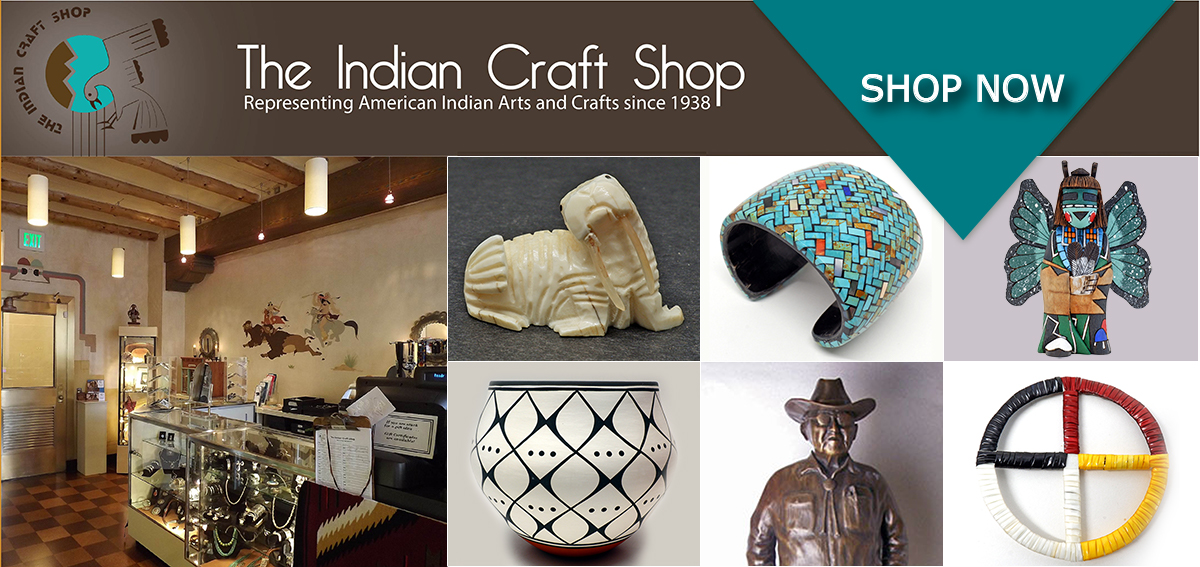Home
About Us
Current News
Event Calendar
Artist Bios
ARCHIVES
Display IDEAS
Collecting Tips
Gen Arts/Crafts Info
Testimonials
Hours/Directions
Online Store
ARCHIVES - Artist / Highlight of the Month
ARTS of the ALASKA - 2011
The Highlight of the Month program at The Indian Craft Shop focuses on a particular craft area, region or artist family/group. Our aim is to illustrate the diversity of tribal groups and the wide variety of artistic expressions and traditions in the country today.
See our online store for selected works from Alaska
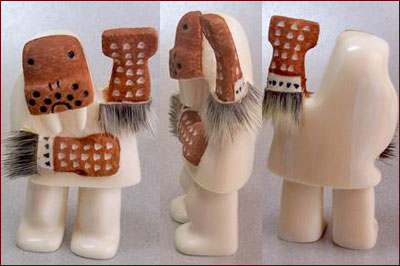
Carving - Dancer, Walrus -- Ivory & Seal Fur
by Tom Tiulana (Inupiat)
The arts from Alaska include a great variety of traditional and contemporary works, often reflecting the rich Alaskan Native cultures. Many of the arts have origins in tradition and function, made from materials of a subsistence lifestyle and of those indigenous to the different areas of Alaska. The vast region of Alaska includes several distinct cultural groups. The Tlingit, Haida and Tsimshian are in the southeast with heavily forested lands, glacier-carved fjords and bays. The Aleut and Alutiiq are in the southwest from Prince William Sound to the Aleutian Islands. The Yup’ik and Inupiat, historically known as the Eskimo, are located from Bristol Bay through the tundra of the northern Arctic to the Canadian border. The Athabascan are located from the interior of Alaska to the Canadian border.
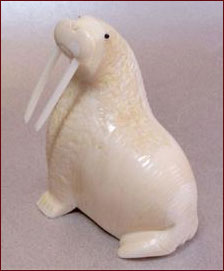
Carving - Walrus - Ivory, Baleen by Brandon Oseuk (Yup'ik)
Carving of walrus tusk ivory and whalebone is a livelihood for many Yup’ik and Inupiat artists who transform these materials into a variety of expressive figures. Walrus, seal, polar bears and arctic whales are favorite subjects, along with birds, otters, wooly mammoths, wolves and moose. Also depicted are spirit dancers and hunters waiting at seal breathing holes, in kayaks or driving a dog sled. Some include both human and animal elements, depicting the sharing of the spirit and reliance on the hunt. Fossilized ivory is also used, colors ranging from honey brown to deep gray, depending on how long buried and the soil it was found in. Whalebone provides a dramatic medium for carvings of dancers, large figures and masks often inlaid with ivory and baleen. Whalebone, from several decades to centuries old, is gathered during the summer months.
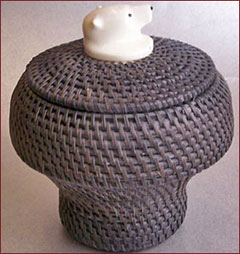 Baskets are made from a wide variety of materials. Baleen, the filtration plates from the toothless whale species, is fashioned into single rod baskets by some Inupiat artists. Using very strong hands, the artist uses an ivory basket start at the base and an ivory finial on the lid. Birch bark containers and coiled grass baskets with dyed seal gut are a specialty of many Athabascan makers. Twining and plaiting are common basketry techniques among groups of southern Alaska where a variety of grasses and split woods and barks, including cedar and spruce root, are formed into utilitarian and decorative containers, woven hats and accessories.
Baskets are made from a wide variety of materials. Baleen, the filtration plates from the toothless whale species, is fashioned into single rod baskets by some Inupiat artists. Using very strong hands, the artist uses an ivory basket start at the base and an ivory finial on the lid. Birch bark containers and coiled grass baskets with dyed seal gut are a specialty of many Athabascan makers. Twining and plaiting are common basketry techniques among groups of southern Alaska where a variety of grasses and split woods and barks, including cedar and spruce root, are formed into utilitarian and decorative containers, woven hats and accessories.
Bold totems and carvings are reflective of the southeastern groups of Alaska. Artists create wood totems, masks, panels, paddles and other carvings, often made of alder and cedar, with some contemporary artists using exotic woods. Totem poles have a long history in Alaska and full sized poles are still made at entrances to homes, businesses and land areas, and for commemorations. The carvings often include family crests such as the Raven and the Eagle and may also be based on ceremonies, hunts or stories.
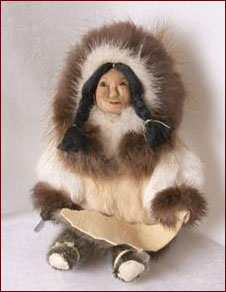 There are a great variety of other crafts and arts of Alaska. Dolls, universally made and used as teaching tools and playing objects, are made out of various skins, woods and furs. Eskimo Yo-Yos challenge and entertain all ages, and sealskin thimbles are prized by seamstresses for their flexibility and protection. Textiles include the complicated woven Chilkat blankets, with designs containing abstract crests and story figures, and worn as robes, aprons, tunics and leggings. Button blankets, with similar designs done in appliqué, are also made for use in dance and ceremony. From the far north there are graceful woven dance fans trimmed with polar bear fur, and hand held walrus stomach drums used for storytelling, dances and songs. Masks of a great variety are made, some with histories of use in ceremonies, in telling stories or playing games, and others that are representative of a food chain or spirit of a hunt. Jewelry is made of many materials, which include ivory, argillite, wood, sterling silver and gold, typically with designs reflective of the artist’s culture area. Beadwork, most common among Athabascan makers, often includes floral patterns in bright colors, with hides such as moose and caribou used as the wearable canvas.
There are a great variety of other crafts and arts of Alaska. Dolls, universally made and used as teaching tools and playing objects, are made out of various skins, woods and furs. Eskimo Yo-Yos challenge and entertain all ages, and sealskin thimbles are prized by seamstresses for their flexibility and protection. Textiles include the complicated woven Chilkat blankets, with designs containing abstract crests and story figures, and worn as robes, aprons, tunics and leggings. Button blankets, with similar designs done in appliqué, are also made for use in dance and ceremony. From the far north there are graceful woven dance fans trimmed with polar bear fur, and hand held walrus stomach drums used for storytelling, dances and songs. Masks of a great variety are made, some with histories of use in ceremonies, in telling stories or playing games, and others that are representative of a food chain or spirit of a hunt. Jewelry is made of many materials, which include ivory, argillite, wood, sterling silver and gold, typically with designs reflective of the artist’s culture area. Beadwork, most common among Athabascan makers, often includes floral patterns in bright colors, with hides such as moose and caribou used as the wearable canvas.
©The Indian Craft Shop 2011
To see our current work, visit our online store at http://www.indiancraftshopsales.com![]()

